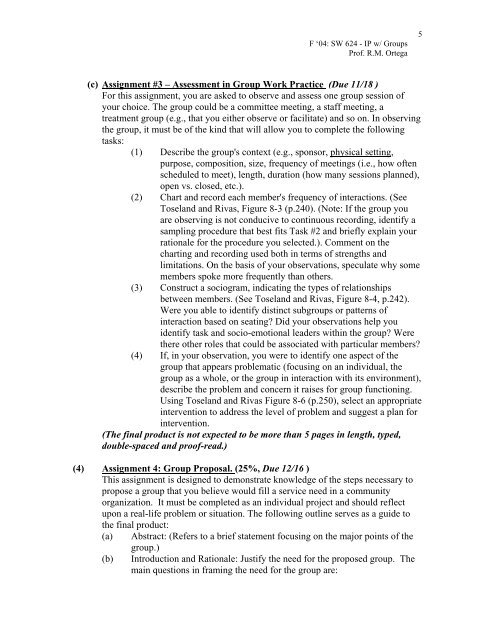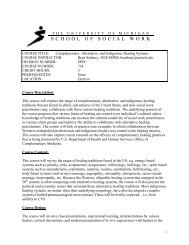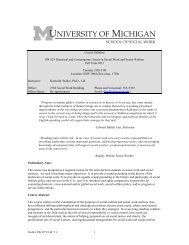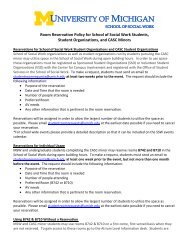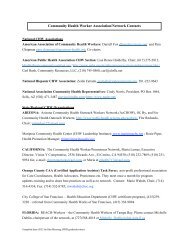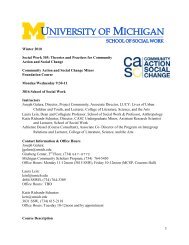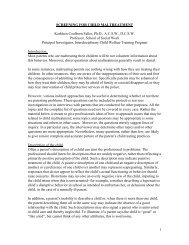Syllabus - University of Michigan School of Social Work
Syllabus - University of Michigan School of Social Work
Syllabus - University of Michigan School of Social Work
Create successful ePaper yourself
Turn your PDF publications into a flip-book with our unique Google optimized e-Paper software.
F ‘04: SW 624 - IP w/ Groups<br />
Pr<strong>of</strong>. R.M. Ortega<br />
5<br />
(c) Assignment #3 – Assessment in Group <strong>Work</strong> Practice (Due 11/18 )<br />
For this assignment, you are asked to observe and assess one group session <strong>of</strong><br />
your choice. The group could be a committee meeting, a staff meeting, a<br />
treatment group (e.g., that you either observe or facilitate) and so on. In observing<br />
the group, it must be <strong>of</strong> the kind that will allow you to complete the following<br />
tasks:<br />
(1) Describe the group's context (e.g., sponsor, physical setting,<br />
purpose, composition, size, frequency <strong>of</strong> meetings (i.e., how <strong>of</strong>ten<br />
scheduled to meet), length, duration (how many sessions planned),<br />
open vs. closed, etc.).<br />
(2) Chart and record each member's frequency <strong>of</strong> interactions. (See<br />
Toseland and Rivas, Figure 8-3 (p.240). (Note: If the group you<br />
are observing is not conducive to continuous recording, identify a<br />
sampling procedure that best fits Task #2 and briefly explain your<br />
rationale for the procedure you selected.). Comment on the<br />
charting and recording used both in terms <strong>of</strong> strengths and<br />
limitations. On the basis <strong>of</strong> your observations, speculate why some<br />
members spoke more frequently than others.<br />
(3) Construct a sociogram, indicating the types <strong>of</strong> relationships<br />
between members. (See Toseland and Rivas, Figure 8-4, p.242).<br />
Were you able to identify distinct subgroups or patterns <strong>of</strong><br />
interaction based on seating? Did your observations help you<br />
identify task and socio-emotional leaders within the group? Were<br />
there other roles that could be associated with particular members?<br />
(4) If, in your observation, you were to identify one aspect <strong>of</strong> the<br />
group that appears problematic (focusing on an individual, the<br />
group as a whole, or the group in interaction with its environment),<br />
describe the problem and concern it raises for group functioning.<br />
Using Toseland and Rivas Figure 8-6 (p.250), select an appropriate<br />
intervention to address the level <strong>of</strong> problem and suggest a plan for<br />
intervention.<br />
(The final product is not expected to be more than 5 pages in length, typed,<br />
double-spaced and pro<strong>of</strong>-read.)<br />
(4) Assignment 4: Group Proposal. (25%, Due 12/16 )<br />
This assignment is designed to demonstrate knowledge <strong>of</strong> the steps necessary to<br />
propose a group that you believe would fill a service need in a community<br />
organization. It must be completed as an individual project and should reflect<br />
upon a real-life problem or situation. The following outline serves as a guide to<br />
the final product:<br />
(a) Abstract: (Refers to a brief statement focusing on the major points <strong>of</strong> the<br />
group.)<br />
(b) Introduction and Rationale: Justify the need for the proposed group. The<br />
main questions in framing the need for the group are:


